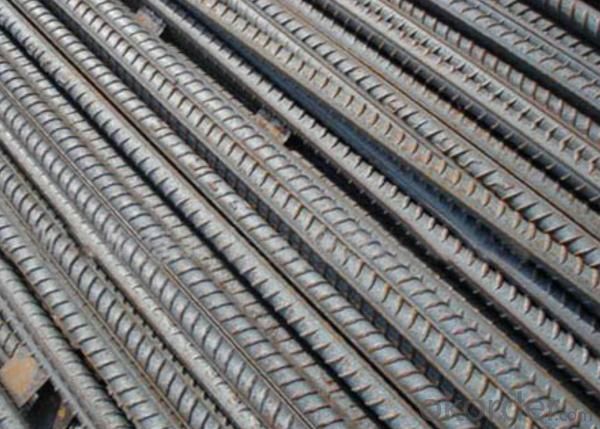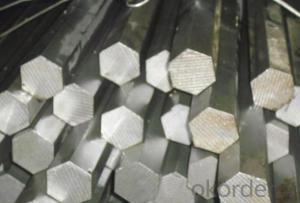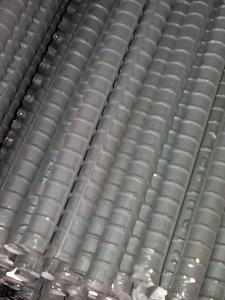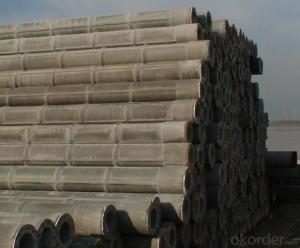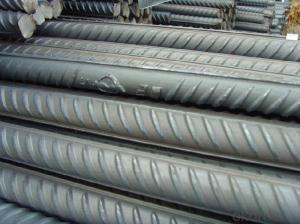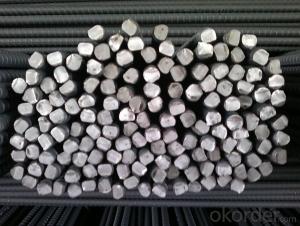Hot Rolled Deformed Steel Rebar
- Loading Port:
- China Main Port
- Payment Terms:
- TT or LC
- Min Order Qty:
- 25MT m.t.
- Supply Capability:
- 800000TONS/YEAR m.t./month
OKorder Service Pledge
OKorder Financial Service
You Might Also Like
Specifications of Hot Rolled Deformed Steel Rebar:
Standard | GB UK USA | HRB335 HRB400 HRB500 G460B, B500A, B500B,B500C GR40, GR60 | |
Diameter | 6mm,8mm,10mm,12mm,14mm,16mm,18mm,20mm, 22mm,25mm,28mm,32mm,36mm,40mm,50mm | ||
Length | 6M, 9M,12M or as required | ||
Payment term | TT or L/C | ||
Trade terms | FOB, CFR, CIF | ||
Application | Building, construction | ||
Each bundle weight | 2-3MT, or as required | ||
Type | Hot rolled steel rebar | ||
Brand name | DRAGON | ||
Theoretical weight and section area of each diameter as below for your information:
Diameter(mm) | Section area (mm²) | Mass(kg/m) | Weight of 12m (kg) | Pcs/ton |
6 | 28.27 | 0.222 | 2.664 | 375.38 |
8 | 50.27 | 0.395 | 4.74 | 210.97 |
10 | 78.54 | 0.617 | 7.404 | 135.06 |
12 | 113.1 | 0.888 | 10.656 | 93.84 |
14 | 153.9 | 1.21 | 14.52 | 68.87 |
16 | 201.1 | 1.58 | 18.96 | 52.74 |
18 | 254.5 | 2.00 | 24 | 41.67 |
20 | 314.2 | 2.47 | 29.64 | 33.74 |
22 | 380.1 | 2.98 | 35.76 | 27.96 |
25 | 490.9 | 3.85 | 46.2 | 21.65 |
28 | 615.8 | 4.83 | 57.96 | 17.25 |
32 | 804.2 | 6.31 | 75.72 | 13.21 |
36 | 1018 | 7.99 | 98.88 | 10.43 |
40 | 1257 | 9.87 | 118.44 | 8.44 |
50 | 1964 | 15.42 | 185.04 | 5.40 |
Deformed Steel Rebar in warehouse
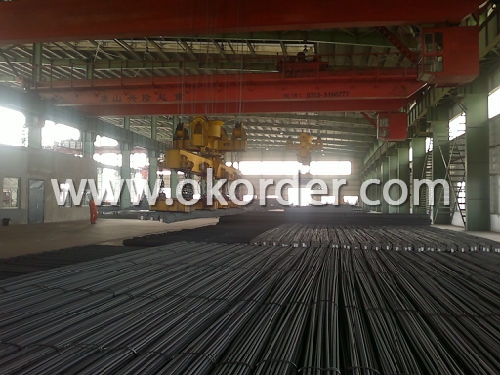

Usage and Applications of Hot Rolled Deformed Steel Rebar:
Deformed bar is widely used in buildings, bridges, roads and other engineering construction. Big to highways, railways, bridges, culverts, tunnels, public facilities such as flood control, dam, small to housing construction, beam, column, wall and the foundation of the plate, deformed bar is an integral structure material. With the development of world economy and the vigorous development of infrastructure construction, real estate, the demand for deformed bar will be larger and larger..
Packaging & Delivery of Hot Rolled Deformed Steel Rebar:
Packaging Detail: products are packed in bundle and then shipped by container or bulk vessel, deformed bar is usually naked strapping delivery, when storing, please pay attention to moisture proof. The performance of rust will produce adverse effect.
Delivery Detail: within 45 days after received advanced payment or LC.
Label: to be specified by customer, generally, each bundle has 1-2 labels
Note:
1. Our products are produced according to national standard (GB), if not, supply according to national standards (GB) or agreement as customer required.
2. Other Grade and Standard Deformed Steel Bar we can supply:
Grade: GR40/GR60, G460B/B500A/B500B/B500C,BST500S
Standard: ASTM, BS, DIN
The Minimum Order Quantity of these products is high, and need to be confirmed.
3. We can not only supply Deformed Steel Bar; if you need anything about building materials, please contact us for further information.
4. Please send us your detail specifications when inquire. We will reply to you as soon as possible. We sincerely hope we can establish a long stable business relationship.
- Q: Are steel rebars easy to handle and install on-site?
- Steel rebars are generally known for their ease of handling and installation on-site. They have widespread usage in construction projects to reinforce concrete structures like buildings, bridges, and roads. The versatility of steel rebars lies in their availability in various sizes and lengths, making them convenient to work with. They can be effortlessly cut, bent, and shaped to meet the specific requirements and design of the structure. Moreover, steel rebars are lightweight in comparison to alternative reinforcement materials, making transportation and maneuverability on-site much simpler. Additionally, their excellent tensile strength ensures both structural stability and durability. However, it is crucial to note that appropriate safety measures need to be taken while handling and installing steel rebars due to their sharpness and potential risk of injury if not managed correctly.
- Q: How do steel rebars provide strength to concrete structures?
- Steel rebars provide strength to concrete structures by acting as reinforcement. When embedded within the concrete, rebars enhance its tensile strength, which is otherwise low. As concrete is strong in compression but weak in tension, the rebars resist the tensile forces that can cause cracking or failure in the structure. By distributing and absorbing these tensile forces, steel rebars increase the overall strength, durability, and structural integrity of the concrete.
- Q: What are the safety precautions to be taken while handling steel rebars?
- When handling steel rebars, there are several safety precautions that should be taken. These include wearing appropriate personal protective equipment (PPE) such as gloves, safety glasses, and steel-toed boots to protect against potential injuries. It is also essential to ensure proper lifting techniques are used to prevent strains or back injuries. Additionally, rebars should be properly stored and secured to avoid any hazards associated with falling or shifting materials. Regular inspections of the rebars for any damage or defects should be conducted, and any faulty or compromised rebars should be replaced immediately. Finally, it is crucial to follow all safety guidelines and protocols established by the employer or construction site to minimize any potential risks or accidents.
- Q: What are the alternatives to steel rebars in construction?
- Some alternatives to steel rebars in construction include fiber reinforced polymer (FRP) rebars, basalt rebars, and stainless steel rebars. FRP rebars are lightweight, corrosion-resistant, and have high tensile strength. Basalt rebars are made from volcanic rock and offer excellent resistance to corrosion and chemicals. Stainless steel rebars have a high resistance to corrosion and maintain their strength at high temperatures. These alternatives provide options for construction projects that require specific performance characteristics or where corrosion is a concern.
- Q: How do steel rebars prevent concrete from cracking?
- Steel rebars prevent concrete from cracking by providing tensile strength to the structure. When concrete is subjected to external forces or loads, it tends to crack due to its low tensile strength. However, by reinforcing it with steel rebars, the concrete becomes more resistant to cracking. The rebars act as structural reinforcement, absorbing the tensile forces and distributing them throughout the concrete, preventing cracks from forming and ensuring the overall stability and durability of the structure.
- Q: How can steel rebars be recycled after their service life?
- Steel rebars can be recycled after their service life by first removing them from the concrete structures they were originally embedded in. Once separated, the rebars are cleaned and sorted based on their size and quality. They are then taken to a recycling facility where they are shredded into small pieces and melted in a furnace. The molten steel is then molded into new rebars or other steel products. This recycling process not only helps conserve natural resources but also reduces waste and the environmental impact of steel production.
- Q: Are there any environmental benefits to using steel rebars?
- There are numerous environmental advantages to utilizing steel rebars in construction. Here are some of the main benefits: 1. Recyclability: Steel rebars possess a high degree of recyclability, enabling them to be reused or repurposed once their lifespan in a structure comes to an end. This diminishes the need for new steel production and the associated energy consumption and greenhouse gas emissions. In fact, steel is one of the most widely recycled materials worldwide, boasting a recycling rate of approximately 90%. 2. Durability: Steel rebars are renowned for their strength and durability, granting structures a longer lifespan. This lessens the necessity for frequent replacements or repairs, resulting in reduced waste generation and the conservation of resources. 3. Energy efficiency: Steel production has become increasingly energy-efficient over time, thanks to advancements in technology and processes. This signifies that the environmental impact of steel production has been decreasing, making it a more sustainable choice in comparison to other materials. 4. Reduced deforestation: Steel rebars provide an alternative to timber reinforcement, which is often acquired through deforestation practices. By opting for steel rebars instead, we can help alleviate the pressure on forests and safeguard their invaluable ecosystem services. 5. Waste reduction: Steel rebars can be prefabricated and cut to precise lengths, minimizing waste on construction sites. Additionally, the scrap generated during the fabrication process can be recycled, further reducing waste generation. In conclusion, the utilization of steel rebars in construction offers a variety of environmental benefits, including recyclability, durability, energy efficiency, reduced deforestation, and waste reduction. These advantages contribute to a more sustainable and eco-friendly construction industry.
- Q: Are there any disadvantages to using steel rebars?
- Yes, there are some disadvantages to using steel rebars. Firstly, steel rebars can corrode over time, especially in environments with high moisture or exposure to chemicals, which can reduce their strength and durability. Additionally, steel rebars are susceptible to thermal expansion and contraction, leading to cracking in concrete structures. Moreover, steel rebars are heavy and can be challenging to handle and transport, making construction processes more labor-intensive.
- Q: What is the role of steel rebars in preventing structural failures?
- The role of steel rebars in preventing structural failures is to provide reinforcement and strength to concrete structures. By adding steel rebars to concrete, the composite material becomes more resistant to tension and bending forces. This helps to distribute and control the stress in the structure, preventing cracks and failure points from developing. The rebars also enhance the overall durability and longevity of the structure, ensuring its stability and safety over time.
- Q: How are steel rebars used in the construction of wastewater treatment plants?
- Steel rebars are used in the construction of wastewater treatment plants to reinforce the concrete structures, such as tanks and basins, that are essential for storing and treating wastewater. The rebars provide strength and stability to these structures, ensuring they can withstand the weight of the water and the various chemicals used in the treatment process. Additionally, the rebars help to prevent cracking and structural failure, ensuring the longevity and reliability of the wastewater treatment plant.
1. Manufacturer Overview
| Location | Hebei, China |
| Year Established | 2002 |
| Annual Output Value | Above US$ 400 Million |
| Main Markets | South Asia; Middle East;Southeast Aisa |
| Company Certifications |
2. Manufacturer Certificates
| a) Certification Name | |
| Range | |
| Reference | |
| Validity Period |
3. Manufacturer Capability
| a) Trade Capacity | |
| Nearest Port | Tianjin |
| Export Percentage | 60%-80% |
| No.of Employees in Trade Department | 11-20 People |
| Language Spoken: | English; Chinese |
| b) Factory Information | |
| Factory Size: | Above 100,000 square meters |
| No. of Production Lines | 2 |
| Contract Manufacturing | OEM service offered |
| Product Price Range | average |
Send your message to us
Hot Rolled Deformed Steel Rebar
- Loading Port:
- China Main Port
- Payment Terms:
- TT or LC
- Min Order Qty:
- 25MT m.t.
- Supply Capability:
- 800000TONS/YEAR m.t./month
OKorder Service Pledge
OKorder Financial Service
Similar products
Hot products
Hot Searches
Related keywords



